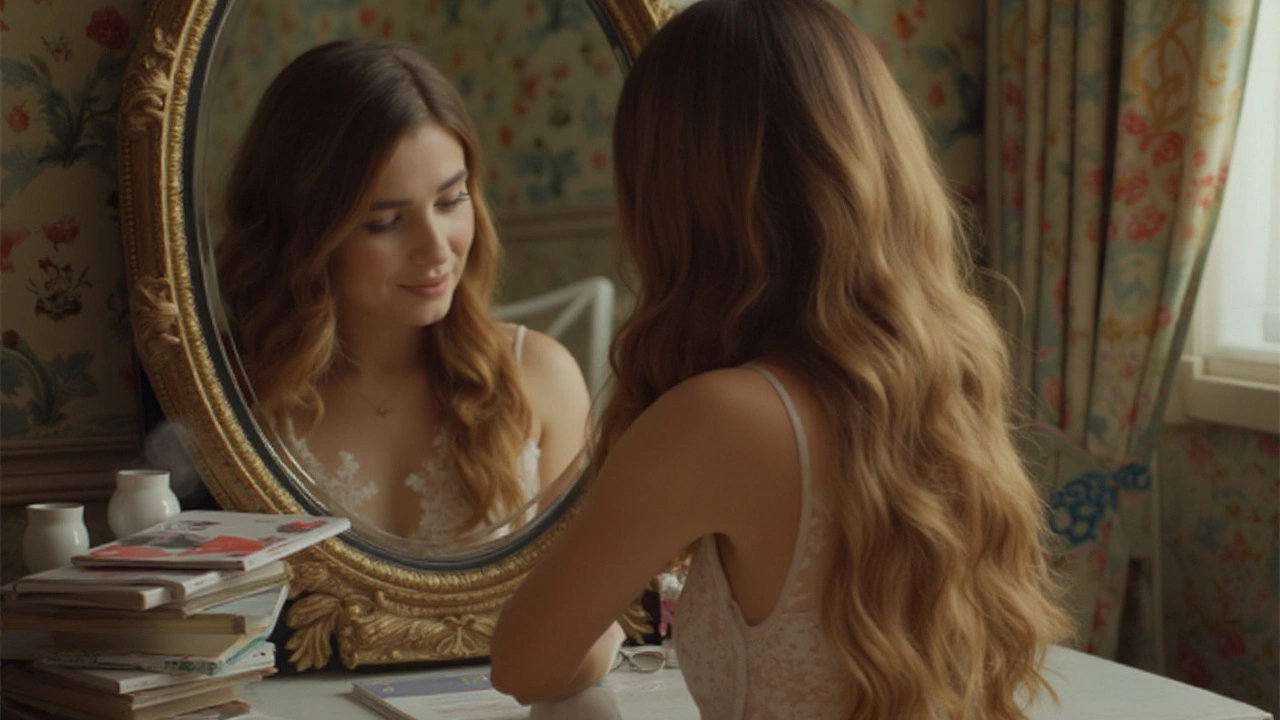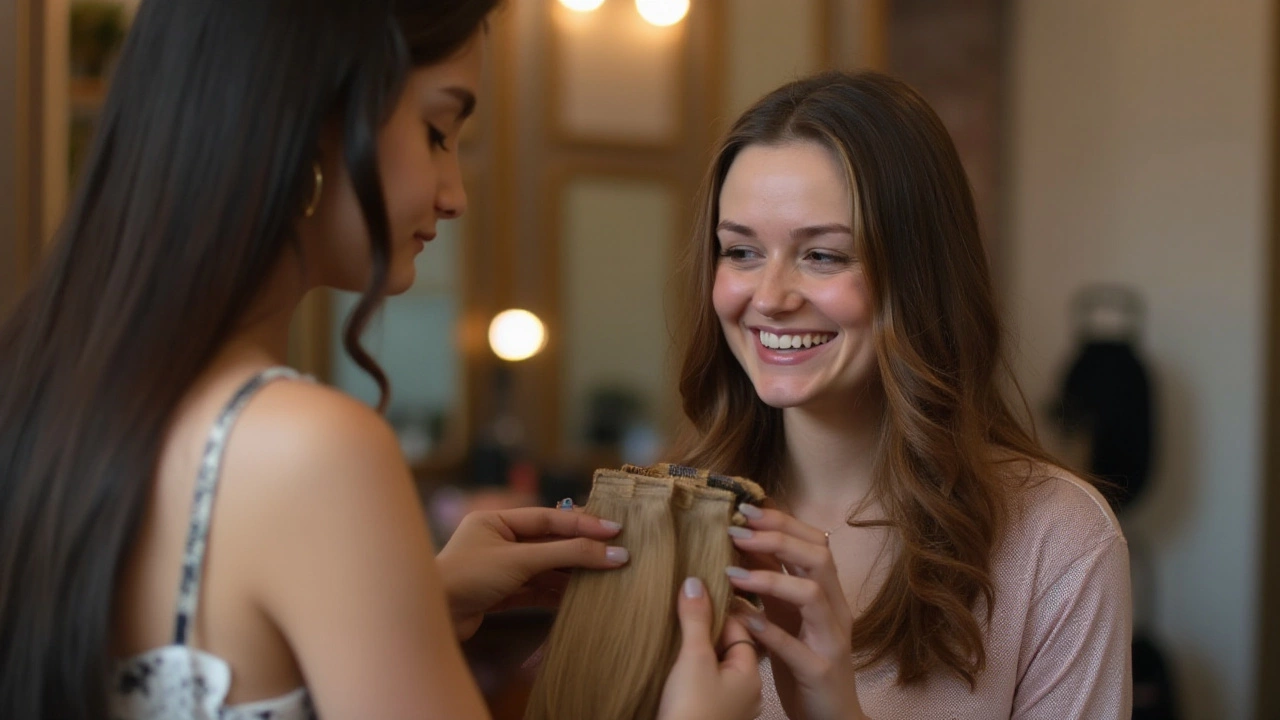Hair extensions have long been a secret weapon in the beauty arsenal of many, offering volume, length, and versatility with ease. But an interesting question arises—can they also help with growing your own natural hair? This is a query pondered by many who yearn for longer tresses but want to avoid damaging their natural locks.
Before diving headfirst into extensions as a growth strategy, it's essential to weigh the benefits and drawbacks. Extensions can indeed protect your natural hair by reducing exposure to everyday styling and environmental damage. However, they require proper care and choice to avoid unintended setbacks.
Join us as we explore the dynamics between extensions and natural hair growth, dispel common myths, and offer tangible tips to ensure your hair remains healthy and strong throughout your journey to longer locks.
- Understanding Hair Extensions
- The Science Behind Hair Growth
- Do Extensions Encourage Natural Growth?
- Potential Risks and Misconceptions
- Choosing the Right Extensions for You
- Tips for Healthy Maintenance
Understanding Hair Extensions
When diving into the world of hair extensions, it's akin to unraveling a treasure trove of beauty possibilities. Extensions are not just mere additions to your hair; they bridge the gap between your current hair reality and the one you dream of. They come in various forms, each with its unique flair and use-case scenarios. From clip-ins that you can pop in and out with ease to sew-ins that become a part of your daily routine, the choices are vast and varied.
Extensions have been around for quite a while, and their evolution is a testament to the growing innovation within the beauty industry. Historically, as far back as ancient Egypt, people have been enhancing their locks by adding extra hair. Fast-forward to today, hair extensions have become a staple in beauty regimes worldwide, admired for their ability to transform looks instantly. Despite their growing popularity, understanding the different methods and materials can sometimes feel overwhelming.
Each type functions differently and provides a unique result. Clip-in extensions are revered for their convenience, allowing one to change their look almost as quickly as changing an outfit. On the other hand, tape-ins offer a degree of semi-permanence that many find appealing due to their natural appearance. There's a growing interest in micro-link extensions, which offer a dynamic blend of sustainability and aesthetic charm, especially for those committed to long-term hair enhancement.
"Hair extensions are the newest frontier of personal expression. It's not just adding volume; it's about creating the kind of beauty and confidence that turns heads," a well-known stylist once mentioned in a beauty symposium.
The craftsmanship behind extensions has also improved, with many moving away from synthetic fibers towards ethically sourced human hair, which offers more natural results. Color matching and texture blending have become scientific endeavors, ensuring that the extensions enhance rather than simply add-on. However, choosing the right type of extension is crucial. Consider your lifestyle, hair type, and the kind of maintenance you’re prepared to undertake. Selecting extensions goes beyond wanting longer hair; it demands an understanding of how they will integrate with your daily routine and hair health practices.
Engaging with a seasoned stylist can make all the difference. Their expertise in choosing not only the right type of hair but also in flawless application can help you avoid common pitfalls. Extensions should enhance your natural hair's beauty, not compromise it, and this is achievable when the options are navigated with care and understanding.
Hair care enthusiasts will find that the journey with extensions is both rewarding and enlightening, offering a fresh canvas to experiment with styles, lengths, and colors without the permanence of dye or drastic cuts. It opens a realm of possibilities, turning ambitions of voluminous, long hair into an attainable reality.
The Science Behind Hair Growth
Understanding hair growth starts with a basic knowledge of its cycle. Hair grows from follicles, which are tiny sacs located in the skin. Each strand of hair is secured within a follicle. Hair growth occurs in three specific stages: anagen, catagen, and telogen. The anagen phase is the growth period, which can last anywhere from two to six years. During this time, cells in the hair bulb divide rapidly, resulting in longer hair. The catagen phase is a brief transitional phase, where the hair stops growing and detaches from the blood supply. Finally, the telogen phase is the resting period, typically lasting a few months, before the hair eventually falls out to allow a new strand to begin growing.
The length of time your hair remains in the anagen phase is largely determined by genetics, which means that those blessed with a longer growth phase will often have hair that can grow longer than those whose anagen phase is shorter. However, hair growth can also be influenced by age, health, and diet. For instance, as we age, the length of this growth phase can decrease, which might explain why your grandma's hair may not reach her waist as it did in her youth. Hormonal changes, nutritional deficiencies, and stress can all disrupt the hair growth cycle, potentially leading to hair thinning or loss.
It’s important to note that while it is impossible to change the genetically predetermined aspects of your hair growth cycle, there are ways to optimize the conditions for growth. Eating a balanced diet rich in vitamins and minerals can promote healthier, stronger hair. Additionally, maintaining a stress-free lifestyle, using nourishing hair care products, and protecting hair from excessive styling or environmental damage can help support optimal hair health and growth.
Dr. Francesca Fusco, a New York City-based dermatologist, states, "Healthy hair growth is more than just selecting the right hair care products; it's about nurturing your scalp and ensuring your body has all the nutrients it needs." Her words emphasize the importance of a holistic approach to achieving lush and healthy hair.
Interestingly, some studies suggest that heightened scalp tension can negatively impact the anchoring of hair roots and promote hair loss, showcasing the complexity of the hair growth process. Regular scalp massages and minimizing hairstyles that apply strain can be beneficial. By understanding and respecting the natural hair cycle, and with diligent hair care routines, it is possible to achieve both healthier hair and the length you desire.

Do Extensions Encourage Natural Growth?
It's easy to see why many are curious about whether hair extensions can foster natural hair growth. The allure of longer, thicker locks without waiting for Mother Nature has a strong appeal. Some people claim that by wearing extensions, they experienced faster growth of their own hair, but how much of this is truth and how much is beauty myth?
The primary way extensions might influence growth is rather indirect. When properly applied and maintained, extensions can act as a protective barrier. They minimize exposure to heat and environmental factors by reducing the need to style natural hair as frequently. This can mitigate breakage and allow for healthier ends. Healthy ends are crucial because when hair is less prone to break, it retains length over time. However, directly promoting growth through extensions can be misleading. The hair follicles themselves are largely unaffected by extensions.
"Extensions can be both a boon and a bane," says Dr. Carla Ruiz, a renowned trichologist. "While they can protect from environmental damage, they must be managed carefully to ensure they don't lead to traction alopecia or other forms of hair weakening."
There are indeed certain types of extensions that might be more conducive to healthier hair practices. For example, clip-in extensions are less likely to cause any pulling on the scalp, whereas sewn-in or glue-based options might stress the roots if not applied correctly. Rotate the location of your extensions and take frequent breaks to ensure the scalp and hair receive periods of rest. This concept supports the idea that some types of extensions can lead to better hair retention and indicate an indirect benefit relating to growth by facilitating a healthier hair care routine.
In hair care, misconceptions can easily arise. However, the emphasis should always be on treating both your natural hair and extensions with gentility and care. Proper support from nourishing products, like those rich in biotin or keratin, and routine moisturization can help preserve hair health while sporting extensions. It's also worth mentioning that hair growth rates are predominantly determined by genetics, diet, and overall health, rather than the hair treatments we employ.
Potential Risks and Misconceptions
When considering hair extensions as a way to enhance your look or possibly boost natural hair growth, it's crucial to recognize both myths and associated risks. A common misconception is that extensions inherently lead to faster hair growth. Extensions themselves don't actually affect the rate of your hair’s natural growth cycle, which averages around half an inch per month for most people. While they provide appealing visuals of instant length, they don’t immediately transform how your scalp produces hair.
Instead, hair extensions can act as protective styles, minimizing breakage from daily styling practices. However, this protective benefit is only true when extensions are applied and maintained properly. Too-tightly installed extensions can lead to tension alopecia, where the hair is pulled from its follicle, an often-painful experience that can result in permanent hair loss if not addressed promptly. It’s vital to always opt for a professional installation by someone well-versed in hair care.
"The key to using extensions successfully is understanding your hair's capacity for stress," says Dr. Linda Williams, a prominent dermatologist in hair science. "Choose lighter extensions if your hair is naturally fine; heavier options might require your natural hair to shoulder more than it can comfortably handle."
Another misconception is the belief that frequent use of hair extensions inherently damages your hair. While poor-quality extensions or improper attachment and removal can harm hair, high-quality extensions used sensibly often pose minimal risk. Learning how to handle your extensions properly can prevent any potential damage, maintaining both the integrity of your natural hair and the lifespan of the extensions themselves.
It's also noteworthy to mention the importance of proper hair care products specific for those using hair extensions. Shampoos and conditioners that are sulfate-free help keep both scalp and extensions moisturized, preventing accidental dryness and breakage. Regular maintenance appointments ensure that any weave or bond remains secure, reducing risks of slippage or unwanted stress on the hair shafts.
Lastly, although extensions are a fun and glamorous way to instantly change your look, they do require budgeting time and finances. Frequent repositioning is usually needed every six to eight weeks to accommodate your own hair growth, making professional care necessary, which can accumulate cost over time. As with any beauty option, weighing the benefits against possible setbacks helps ensure a pleasant and informed experience on your hair journey.

Choosing the Right Extensions for You
When it comes to selecting the perfect hair extensions, the journey can often feel like navigating a labyrinth of options and decisions. With various types, textures, and application methods available, making the right choice might seem overwhelming at first. The key lies in matching extensions with your natural hair not just in terms of color, but also texture and weight, to avoid unnecessary stress on your scalp and strands. Opting for hair extensions that blend seamlessly with your natural locks amplifies the harmony between them and minimizes the risk of damage.
Start by considering the type of extensions that would most benefit your lifestyle. Clip-in extensions are a fantastic option for those seeking flexibility and ease, allowing you to remove them anytime, offering an excellent balance between commitment and versatility. Meanwhile, tape-in extensions are ideal for a more semi-permanent solution, often recommended for short to medium-term wear. Sewn-in or bonded extensions provide a more lasting result, but they do require professional application and maintenance to prevent stress on your natural hair.
"Investing in high-quality extensions is crucial," advises celebrity hairstylist Jen Atkins, "as they tend to be less damaging and provide a more natural finish."
Next, consider the material of the extensions. Human hair extensions provide the most natural look and feel and can be styled just like your own hair. Their versatility allows for dyeing and heat styling, which can be a significant bonus for those who frequently change their hairstyle. On the other hand, synthetic extensions, while generally more affordable, pose limitations as they cannot handle heat or chemicals often deteriorating quickly under styling tools.
Pay attention to the installation and maintenance methods too, as they can vary significantly. Extensions like micro-links or I-tips allow individual application and may reduce bulk and tension, provided they are installed by a professional. Tape and sew-in methods require a precise technique to ensure they lay flat against the scalp and do not tug at the roots. Regular maintenance appointments are crucial in these cases to reposition extensions as natural hair grows.
Finally, consider the ethics and sustainability of your extensions. Many companies now offer ethically sourced hair, considering the conditions in which hair is obtained and emphasizing environmental sustainability. Being mindful of these elements not only helps in making informed decisions but also promotes responsible beauty practices.
In summary, choosing the right hair extensions involves a mindful understanding of your preferences and lifestyle needs, coupled with a respect for the natural hair onto which they will attach. By taking into account these factors, you can enjoy the benefits that extensions offer without compromising the health of your natural hair.
Tips for Healthy Maintenance
When it comes to keeping both your hair extensions and natural hair in great shape, a thoughtful maintenance routine is key. Extensions can certainly help you achieve the look you desire, but it's important to give them the attention they need so they don't compromise your hair health. Start by washing your extensions gently to preserve their longevity. Use a sulfate-free shampoo and conditioner to maintain their softness and shine. Remember, extensions don't benefit from natural scalp oils like your own hair, so hydration is crucial.
Brushing your hair extensions carefully is another must. Using the right brush can prevent tangling and unnecessary strain on the bonds. A wide-tooth comb is often recommended to detangle while causing the least amount of damage. Ensure you handle your hair with care, beginning at the tips and gradually working your way toward the roots. This method can help avoid pulling and breaking both the extension strands and your own hair.
Heat tools may be part of your daily routine, but for the health of your extensions and natural hair, limit their use. When you do decide to style with heat, always apply a heat protectant spray. This simple step can prevent the damage caused by high temperatures, and keep your hair looking vibrant and healthy. Consider air drying whenever possible, as it's a gentle method that reduces wear and tear over time.
Nighttime care should not be overlooked. Tie your hair in a loose braid or use a silk pillowcase to reduce friction while you sleep. This can cut down on frizziness and maintain the sleek look of your hair extensions. Additionally, scheduling regular salon visits to re-bond or tighten extensions will help maintain both their integrity and appearance for the long haul.
Nutrition plays a role, too, so don't forget that a balanced diet rich in vitamins and minerals can enhance your hair's health from the inside out. Incorporating foods rich in omega-3 fatty acids, proteins, and vitamins A and C can bolster hair growth and prevent breakage. This holistic approach ensures that not only do your extensions shine, but your natural hair flourishes as well.
According to hair expert Sarah Goldstein, "The key to prolonging the lifespan of your extensions while keeping your natural hair healthy is consistent and gentle care. Avoiding mechanical stress and ensuring the right hydration levels are the best practices you can adopt."
Ultimately, proper hair care is a marathon, not a sprint. Employing these strategies ensures that as you enjoy the luxury and style of hair extensions, your natural hair is given the best chance to grow and thrive. The right maintenance routine can foster a harmonious relationship between extensions and your authentic locks, making a huge difference to your hair's overall look and health.

